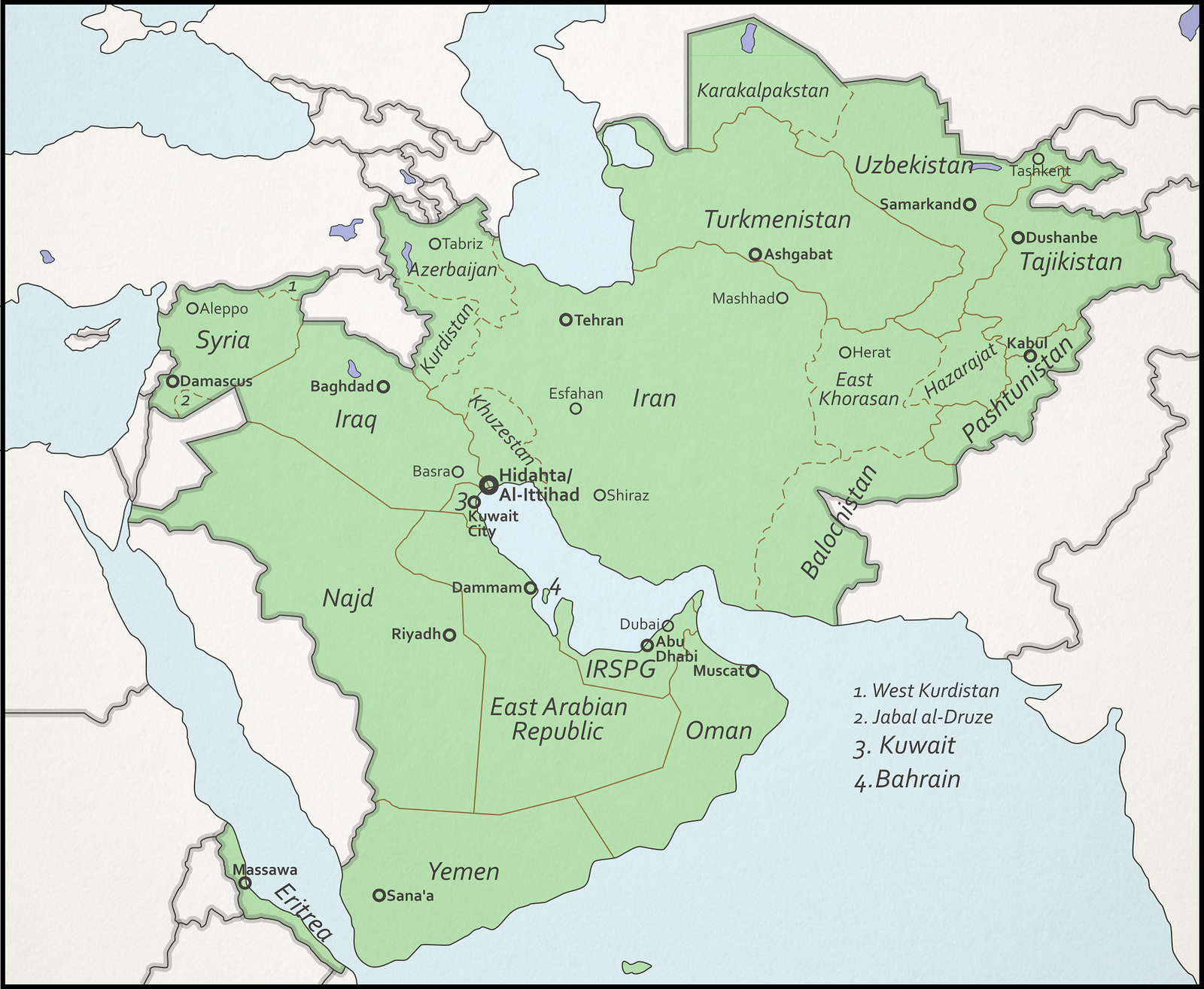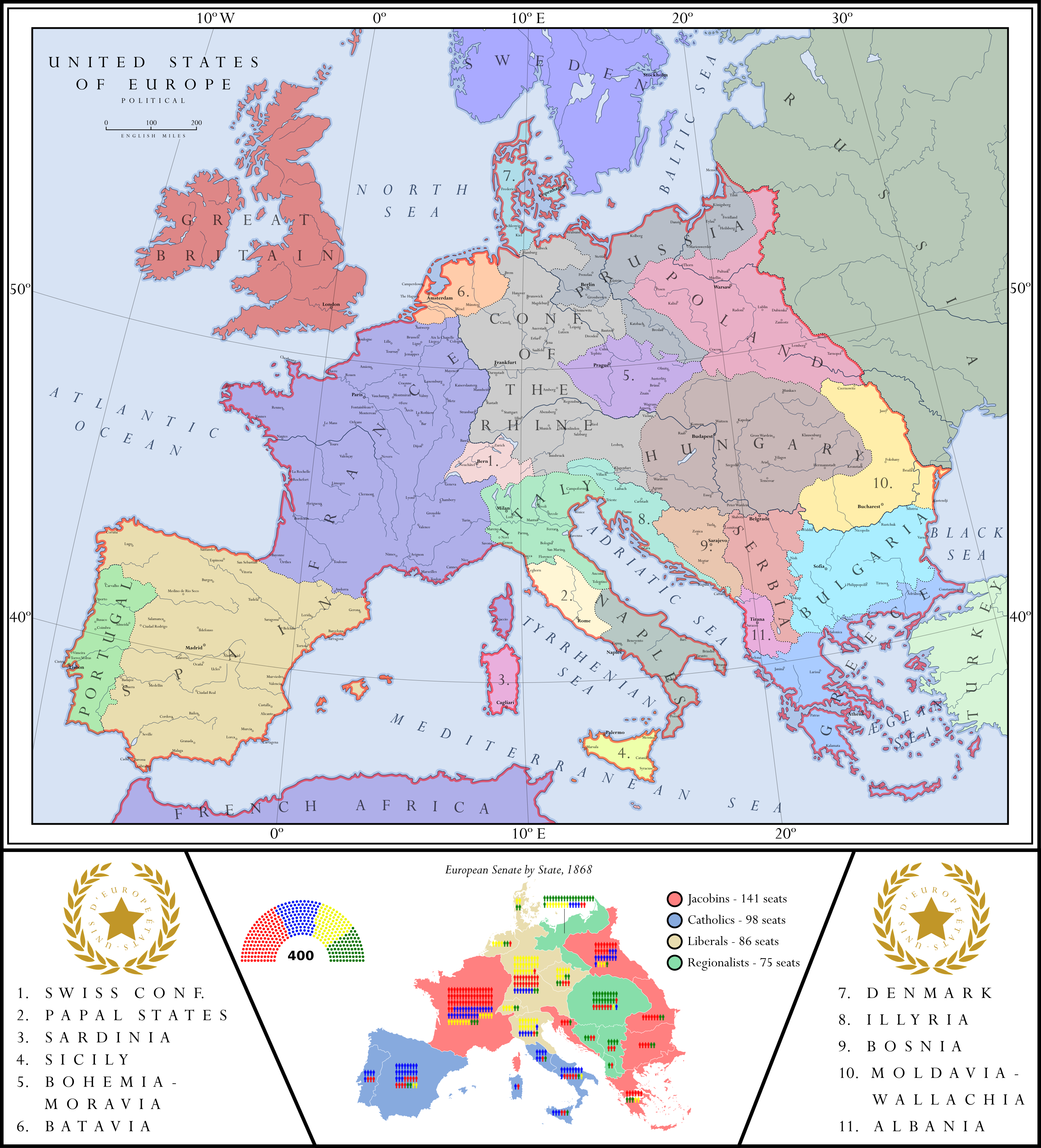The direct origins of the Union of Islamic Republics come from the Syrian and Iraqi Civil Wars of the 2010s, in which Iran supported the governments of those countries in defeating Da’esh and, in Syria, various other groups rebelling against their government. After Iraq and Syria had been fully stabilized in 2019, the alliance between the three was formalized as the Middle East Council.
Iran, Iraq, and Syria had in common that they were all led by Shia Muslims. The great majority of Iran is Shia, and following the 2018 secession of Iraqi Kurdistan and with it not only Kurdish Sunnis but many Arab Sunnis, so was Iraq. Although Shias were a minority in Syria, the highly destructive war had disproportionately affected Sunni regions, increasing the Shia proportion in the country.
The Middle East Council was opposed by Saudi Arabia and its allies, as well as Israel. Following a series of failed interventions in the region, the United States was hit by a wave of isolationism and, though still an opponent of the MEC, was much less involved in the region than they had been just a few years ago.
In 2020, Yemen entered the MEC- or, more specifically, the Iran-supported ‘Houthi government’ of Yemen did, which was opposed by the Saudi-supported ‘Hadi government’. Meanwhile, the authoritarian monarchy of Saudi Arabia was seeing increasing opposition within itself. With greatly decreased economic and military ties to America, Saudi Arabia was having greater difficulty holding itself together. In a repeat of what had occurred in many Arab countries a decade earlier, protests became riots, and when the government intervened with force, it broke out into warfare. Rebellions broke out in other Gulf states- Qatar, Bahrain, and the UAE. The MEC countries initially provided non-military support to these rebels, but soon they had troops on the ground and the entire Arabian peninsula was in a state of war, the only neutral country being Oman. With their popular support, the MEC quickly gained the upper hand.
Within a year, a new order existed in the Arabian peninsula. Saudi Arabia was trisected- the west became the neutral Republic of Hejaz, the center was a remnant Saudi Arabia, and the Shia-majority east was the East Arabian Republic, a member of the MEC. A small area in the south was also given to Yemen. Bahrain, no longer under the Al-Khalifa monarchy, was also a MEC country. Qatar and the UAE were in an unusual position. The majority of their residents had been foreign workers, most of which had fled. These territories were placed under an MEC military government, which was quite harsh to the remaining population. People from other parts of the MEC were encouraged to immigrate and become a ‘replacement population’. Eventually, the territory that had formerly been Qatar and the UAE became the Islamic Republic of the South Persian Gulf, an Iranian puppet even more so than other MEC countries.
In addition, the Middle East Council was renamed the Union of Islamic Republics, and became closer to a supranational union than a simple alliance. This union’s capital would be a new city along the Iran-Iraq border and near the Persian Gulf called Hidahta in Farsi and Al-Ittihad in Arabic, meaning ‘Unification’.
In the 2020s, the UIR took advantage of troubles in the decaying post-Soviet regimes in the Central Asian nations, gaining influence over changing regimes. Turkmenistan, Uzbekistan, and Tajikistan joined the UIR. Even the remnant Saudi state failed to hold power, and following a UIR-backed coup, it became the Islamic Republic of Najd and joined the UIR.
Meanwhile, Afghanistan was destabilizing. Its government was weak, and the Taliban was regaining power, as were other insurgent movements. This had a destabilizing effect on eastern Iran, including several terrorist attacks occurring in the region. The UIR had enough of this, and in 2034 they invaded Afghanistan to restore stability. After some years of military occupation, they unexpectedly made the move to dissolve Afghanistan. Iran annexed the western portion, much of it Farsi-speaking, Tajikistan gained the Tajik areas in the northeast, and the remnant became the Republic of Pashtunistan.
In 2040, the Union of Islamic Republics has made further moves toward unification, prompting debate over whether it should at this point be considered a single country. Its members retain different systems of government and separate UN seats, but the UIR has a unified military, a semi-unified economy, and unified foreign relations. Its most recent entries are Oman, in which an increasingly centralizing monarchy prompted a UIR-sponsored revolution, and the Islamic Republic of Eritrea, which was created after a civil war in Eritrea ended in a ceasefire and the small eastern half looked the UIR for protection. Although the UIR’s central government is a parliament elected democratically from each republic, individual member states have varying levels of democracy.
The UIR was once strongly backed by Russia, but various disputes have decayed their relationship. Now, they look toward India, Europe, and ironically, now the USA, which is ending its isolationist period, for allies. They need these allies to help defend against a Turkish, Egyptian, and Pakistani alliance created to defend against further UIR expansion and provide an alternative power in the Muslim world.



